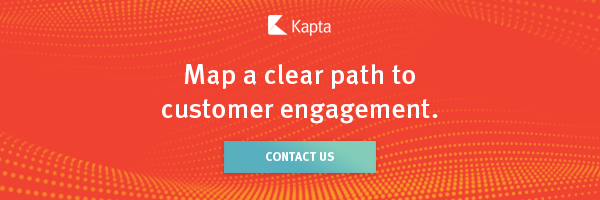Where Communication Fits Into the Key Account Management Maturity Model
in Maturity Model /The key to excellence is communication. Every member of your team benefits from strong internal communication practices, intuitive communication tools, and easier access to information. Your clients also benefit from more structured client-facing communication and fewer internal silos.
According to statistics curated by Gravy, "The most important thing a company can do to provide a quality customer service experience (according to 66% of people asked) is to value customer time." Without a strong communication platform, your organization will repeat information, seem unorganized, miss out on timely follow-ups, and ultimately lose customers.
See how evaluating your team through the lens of a maturity model can drive clearer communication and more successful business practices for your key account management team.
What Is a Maturity Model?
A maturity model illustrates levels of development exhibited by an individual, team, or organization — the subject — in a specific area or theme. As the subject develops a more nuanced understanding of core concepts and gains new skills and competencies, they rise to new levels of the maturity model, moving from a base level to higher and higher tiers of performance. Maturity models are excellent for demonstrating growth in areas that can't be easily quantified, such as a focus on customer excellence, collaboration, and other professional areas where quantifiable metrics or either hollow or too tangential to be useful.
Maturity model frameworks describe both the characteristics the subject should exhibit at each level of maturity, as well as the characteristics or types of actions and mindsets needed to reach the next level. These tools allow managers, executives, and the subjects themselves to gauge their current position, compare it to past performance, set goals for themselves, and have a baseline of maturity for future evaluations.
One of the key models useful in key account management teams is the key account management maturity model. This framework shows how individuals, teams, and leadership roles communicate within a department or the whole organization. Successfully reaching new levels within the maturity level facilities better understanding, increases transparency, and reduces the risk of silos and inter-departmental frustration that interferes with creating an excellent client experience.
Explore the complete account manager's guide to the Key Account Management Maturity Model here.
Where Communication Fits Into the Key Account Management Maturity Model
Understanding the communication piece of the key account management maturity model is an essential first step to improving communications throughout your organization or team. Learn more about the five levels in the framework, the communication styles and characteristics at each level, and how to reach the next tier. For each level, there are internal and external markers to consider.
Level 1: Ad Hoc
At this level, communication is not cohesive. A variety of communication methods are used with little to no tracking, integration, or holistic management.
Internal
Everyone in the organization is frustrated because information is hard to find, and there are no consistent records. Communication tools don't speak to each other, so individuals have to comb through emails, phone messages, notes, and internal documents to locate specific information. There's no connection between the main communication channels — generally, email and phone calls —and phone calls don't have transcripts or saved audio files. This introduces barriers to communication, meaning most information won't be communicated.
External
Emails, calls, and meetings are untracked and unorganized. Clients may fail to receive vital information or will receive repetitive notices. Even worse, clients perceive your company as unorganized, inefficient, and unprofessional, which increases overall client churn.
To reach the next level of the maturity model, your organization must recognize there is a problem and be committed to making some sort of change.
Level 2: Awareness
At this level, there are some efforts to collect information and keep records. But these efforts are disjointed and inconsistent.
Internal
Account managers, marketers, salespeople, and customer service representatives cannot adequately track customer information and the progress of accounts. Employees are frustrated, and there's a lot of lost information.
External
Clients also become frustrated at disjointed meetings, lost or repeated information, and the lack of follow-up. As a result, clients lose confidence in their account managers and the whole organization. Account managers also have increased anxiety and stress because the work is piling up, there are no profitable results, and they don't have the resources to do a better job.
To reach the next stage, the subject needs to be ready to invest time, effort, and (on an organizational or leadership level) money to create better infrastructure and systematic approaches.
Level 3: Repeatable
At this stage, communication becomes consistent and, in large part, sufficient for moderate client success.
Internal
Internally, employees can take better client notes and maintain those records. Typically the organization has implemented an internal system that offers solutions for many of their problems or integrates with other systems to break down their communication barriers.
Information is becoming more accessible to people on the team, in other departments, and in leadership positions. This creates a more cohesive service and saves time because individuals are no longer fruitlessly searching for records.
External
Your clients also benefit from increased communication standards. The top 20% (or more) have consistent quarterly business reviews (QBRs), calls and conversations are thoroughly documented, and followups happen as promised. This increases client confidence and satisfaction.
However, proactive communication isn't happening quite yet. To reach the next stage, the organization as a whole needs to commit to customer-centric actions and approaches.
Level 4: Predictable
At this stage, processes become consistent and more proactive.
Internal
Anyone within the organization can view information as they need it, and the information is easy to find and use. No one has to request notes or information from the AM, as it's readily available. Communication tools and dashboards allow people to see the status of any client at a glance so outreach efforts can be targeted appropriately.
External
Clients of all sizes have the level of communication they need and expect: key accounts and top accounts have QBRs with a strong, regular cadence, and small customers receive tactical communications. Clients enjoy the level of service and support they're receiving.
The jump to the fifth level is all about maximizing focus on client success in every area of business.
Level 5: Activating
At this stage, communication is transparent and built around providing excellence.
Internal
Everyone on the team receives clear and consistent communication. They have easy access to all the information they need, and there are consistent efforts to ensure everyone is on the same page.
External
Clients love the proactively scheduled meetings with clear agendas, fast follow-ups, and a clear focus on providing value.
Implement Better Communication Through the KAM Maturity Model With the Right Software From Kapta
At Kapta, we specialize in providing communication tools and account management platforms that help your team climb through the key account management maturity model. With the right infrastructure to support strategic notes, proactive meetings, and ongoing strategy developments, your team can quickly become client-focused and grow your business. Contact us today to learn more or to schedule a demo.








